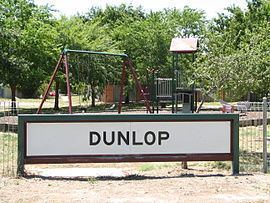Population 7,109 (2011 census) Postal code 2615 | Postcode(s) 2615 Area 3.6 km² Gazetted 22 September 1993 | |
 | ||
Dunlop is a suburb of the Belconnen district of Canberra, located within the Australian Capital Territory, Australia. Dunlop is at the far north-west edge of Canberra, near the border with the state of New South Wales. Approximately 11.6 kilometres (7.2 mi) north-west of the city, Dunlop is next to the suburbs of Fraser, Charnwood and Macgregor. At the edge and within Dunlop lies the Canberra Nature Park called Dunlop Grasslands Nature Reserve, West Belconnen Ponds, Jarramlee Pond and Fassifern Pond which are part of the Ginninderra Catchment.
Contents
- Map of Dunlop ACT 2615 Australia
- Demographics
- Schools and churches
- Playgrounds and parks
- Estates
- Political representation
- Geology
- References
Map of Dunlop ACT 2615, Australia
Dunlop is named after Lieutenant Colonel Sir Ernest Edward 'Weary' Dunlop AC CMG OBE who was an Australian surgeon and was renowned for his leadership whilst being held prisoner of war by the Japanese during World War II. He was born in Wangaratta, Victoria, Australia. Streets in Dunlop are named after inventors, inventions and artists.
Demographics
In the 2011 Australian Census, there were 7,109 persons usually resident in Dunlop (Suburb): 49.5% were males and 50.5% were females. Of the total population in Dunlop (Suburb) 1.5% were Indigenous persons, compared with 2.5% Indigenous persons in Australia.
The Census showed 26.3% of the population usually resident in Dunlop (Suburb) were children aged between 0–14 years, and 12.1% were persons aged 55 years and over. The median age of persons in Dunlop (Suburb) was 31 years, compared with 37 years for persons in Australia.
The 2011 Census showed that 77.2% of persons usually resident in Dunlop stated they were born in Australia. Other common responses within Dunlop (Suburb) were: England 2.9%, India 1.2%, Vietnam 1.2%, New Zealand 1% and China 0.9%.
In the 2011 Census, the most common responses for religious affiliation for persons usually resident in Dunlop (Suburb) were Catholic 28.2%, No Religion 24.7%, Anglican 16.8%, Uniting Church 3.5% and Islam 2.8%. The 2011 Census also revealed that 55.1% of persons aged 15 years and over usually resident in Dunlop (Suburb) were married, 31.7% never married, 10.6% separated or divorced and 2.5% widowed.
In Dunlop, the median weekly individual income for persons aged 15 years and over who were usual residents was $981, compared with $577 in Australia. The median weekly household income was $2,072, compared with $1,234 in Australia. The median weekly family income was $2,215, compared with $1,481 in Australia. In the 2011 Census, there were 1,988 families in Dunlop (Suburb): 54.2% were couple families with children, 30.4% were couple families without children, 14.3% were one parent families and 1.1% were other families.
Schools and churches
There are no schools within the Dunlop suburb. In the nearby suburbs of Charnwood, Fraser and Macgregor there are several public schools and independent schools; Charnwood-Dunlop Primary School, Fraser Primary School, Macgregor Primary School and St.Thomas Aquinas Catholic Primary School. The nearby High Schools and Colleges are Kingsford Smith School, Melba-Copland School and St Francis Xavier College.
In the suburb of Charnwood there are two churches. In the now closed Charnwood High School is the Canberra Christian Life Centre and just down the road is Saint Thomas Aquinas Catholic Church.
Playgrounds and parks
In the Dunlop suburb there are around 8 children's playgrounds for all ages with an array of play equipment. There are also a number of parks that are grassed and covered with different varieties of trees, large rocks to play on and walking and cycle paths.
Fassifern Homestead was originally a working homestead but by the 1920s it was an active equestrian park. Fassifern Homestead is currently unused and it is owned by Territory and Municipal Services (TAMS).
Estates
The suburb of Dunlop has been designed to have a number of 'estates' which are small areas within the suburb. Some estates range from the beginning of the development of Dunlop and number around 50 houses to the recent development of Ginninderra Ponds with house numbering around in the 100s. All the estates entrances have unique signs and features.
The estates are:
Some street names in the suburb of Dunlop are:
The median house price for the Dunlop suburb (2012) is $485,000.
Political representation
For the purposes of Australian federal elections for the House of Representatives, Dunlop is in the Fenner.
For the purposes of Australian Capital Territory elections for the ACT Legislative Assembly, Dunlop is in the Ginninderra electorate.
Geology
Rocks in Dunlop are from the Silurian age. Deakin Volcanics purple rhyodacite is found in most of Dunlop. Grey tuff from the Laidlaw Volcanics was erupted on top in the south west. The Deakin Fault passes along the north east edge of Dunlop. On the north east of the fault the green-grey dacite and quartz andesite of the Hawkins Volcanics were uplifted.
